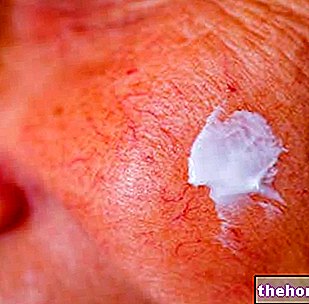What is the "Alume di Rocca"
Rock alum, raw alum and potassium alum are three elementary terms, with the same meaning, which simplify a more complex scientific expression "double aluminum sulphate and potassium dodecahydrate" (chemical formula: KAl (SO4) 2): we are talking about a salt, composed with aluminum and potassium, of sulfuric acid. The term "rock alum " derives from the place where the ancient Greeks extracted the mineral (Rochka).

In fact, some findings have shown that the ancient Romans used to use it and trade it, since they already knew its different properties, widely exploited in different sectors.
In this brief discussion we will analyze the composition of rock alum, its cosmetic uses and its beneficial properties.
Features
Rock alum is commonly extracted from alum (or alumite) stone; however, the raw material can also be bauxite, clay or creolite.
Chemically speaking, rock alum is - let us remember once again - potassium and aluminum sulphate with 12 molecules of water of crystallization: soluble in water and insoluble in alcohol, rock alum has a high astringent power, a taste sweetish or slightly acidic, and crystallizes in regular, monometric and colorless octahedra.
The rock salt melts at 92 ° C in its own water of crystallization. Bringing the temperature between 93 and 200 ° C, the rock alum is precisely called calcined alum or usto, a salt deprived of the initial 12 molecules of water of crystallization. To obtain this result, the high temperature, by evaporating the water, favors the swelling of the mineral, which turns into a porous and spongy mass.
Property
Rock alum is a salt with numerous properties and whose various uses date back to very ancient times.
In fact, it is equipped with:
- Deodorant properties;
- Astringent properties;
- Healing properties;
- Hemostatic properties;
- Soothing properties;
- Antibacterial properties.
Furthermore, the rock alum is able to exert a fixing action of the colors; for this reason, in the past, it was used precisely as a fixative in the coloring processes of fabrics such as wool.
Uses
The astringent and deodorizing power of rock alum is nowadays cleverly exploited by the perfume, cosmetic, chemical and natural industries for the preparation of hypoallergenic, hemostatic and deodorant products.
In the past, the exceptional properties of rock alum were even exploited to make some fabrics fireproof, to whiten the skin (in the ancient 16th century) and, currently, to purify the water.
The main uses for which rock alum is still widely used today will be briefly described below.
Use cosmetics
In the cosmetic-perfumery and natural sectors, rock alum is used as an excellent substitute for the classic underarm deodorant: applied several times on thoroughly cleansed, still damp skin, rock alum has excellent deodorant and antibacterial properties. For the same purpose, the application of rock alum is also recommended to reduce sweat on the feet, reducing - within certain limits - bad odor.
Mechanism of action
The deodorant effectiveness of rock alum is now well known and widely confirmed, although not everyone is able to benefit from its use.
In any case, the question may arise spontaneously: how can a salt exert a deodorizing action?
In case of profuse sweating, rock alum reduces the odor exhaled by the body by exerting an antiperspirant effect: the astringent action that the mineral carries out (excellently) on the skin determines the (temporary) blockage of the sweat glands. osmotic also induces the death of bacterial cells.
In addition, rock alum can also be used as a remedy to relieve the itching of mosquitoes' itching. It is, in fact, sufficient to apply the moistened product directly on the wheal to obtain quick relief.
Rock alum crystals, on the other hand, can be used in cosmetics as physical exfoliating agents, especially useful as a remedy in case of acne and oily skin.

Domestic uses
The deodorizing power of rock alum is also used to absorb unpleasant odors from the refrigerator: available in the form of very fine powder (just like common kitchen salt), it is advisable to place a cup or coffee cup filled with alum powder.
Medical-pharmaceutical uses
Among other therapeutic uses, rock alum is used for its astringent power, as a mild hemostatic (available in special pens), to be applied to the skin after shaving to prevent bleeding from any cuts. The astringent properties of the mineral, associated with those disinfected, they are also used as a natural remedy for canker sores, and as a mild hemostatic to stem the bleeding caused by an animal bite.
To remedy nasal bleeding, it is recommended to dab the area with a cloth soaked in an alum solution: the astringent properties of the material, once again, are used to stop bleeding.
Furthermore, the extraordinary astringent abilities of rock alum are exploited for the preparation of creams touted as "miraculous" for the treatment of hemorrhoids and to prevent bleeding of the gums.
Also in the medical field, rock alum plays its role of prestige: many vaccines, in fact, are formulated precisely with the powders of this mineral, as an adjuvant to increase the body's response to immunogens (substances foreign to the body, in able to elicit a specific immune response.) Rock alum finds, in this case, application in anti hepatitis A and anti hepatitis B vaccines.
Among the most unthinkable properties, the spermicidal power of the mineral also stands out: it seems, in fact, that a solution of 0.5-1% rock alum can somehow kill spermatozoa.
Other uses
The crystals of this very important mineral are also used in the composition of some powders for fire extinguishers (foamite); for this reason, the fireproof properties of rock alum are also exploited for the preparation of fire resistant materials.
Benefits
Benefits and advantages of the use of rock alum in the cosmetic field
As mentioned, the best known use of rock alum is that carried out in the cosmetic field as an alternative to classic deodorants.
This type of use brings with it a number of advantages, since the use of this particular salt:
- It is also suitable for people with sensitive skin and / or allergies to synthetic fragrances.
- It is easily available in perfumery, herbal medicine and even in some supermarkets.
- It is economical and long lasting.
- It does not leave streaks on clothes.
- In addition to being a substitute for deodorant, it can be used as a haemostatic in the case of hair removal or shaving cuts, avoiding the use of other products and thus determining further economic savings.
- It does not contain any kind of synthetic substances, therefore, it can be considered as a natural deodorant.
Side effects
Generally, the rock alum used as a cosmetic is well tolerated and does not cause any kind of side effect.
However, its deodorant effectiveness may not be the same for each individual. Therefore, in some cases, despite its application, some people may still experience the onset of bad odors as a result of sweating.
Contraindications
In general, rock alum for cosmetic use has no contraindications. However, many advise against its continuous and daily application, since - due to its action that prevents the skin from perspiring adequately - in the long run it could lead to counterproductive effects.
Furthermore, there is still a heated debate about its effective safety of use. In fact, some argue that the aluminum salts present in rock alum can be absorbed through the skin pores, damaging the cells of the body and the genetic material (DNA) contained in them.
However, these assumptions have not been confirmed by reliable studies and the topic is still quite controversial.
In any case, as a precaution, if you suffer from particular diseases or if you are being treated with certain types of drugs, before using rock alum, it is good to ask for the advice of your doctor.
Finally, it is good to remember that rock alum must absolutely not be ingested, as it is toxic for the organism.
What to do in case of involuntary ingestion of Alum di Rocca salts
Ingestion of rock alum particles can cause diarrhea, vomiting, abdominal cramps and other gastrointestinal disorders: in such circumstances, it is recommended to take emollient liquids (eg milk) associated with an antacid. rock alum was important, it is recommended to contact a doctor immediately, who will administer an antidote.




























